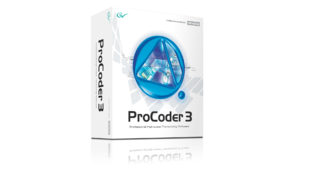Power Full HD converter and Video Editing. The solution is a
batch-encoding application like ProCoder. First, we imported our source
video into the application. We then configured our encoding settings for
each of the above situations.

The art of the compressionist is an arcane one at best. For many, the final encode for distribution is an anti-climactic and tedious process. If you regularly need to process your video in multiple formats or have multiple files that you want to automatically encode to a single format, a transcoding application, such as Canopus ProCoder, is almost a necessity. This review is based on the 1.21.02 update from Canopus.
The Problem
The problem is simple to state: you shoot, edit and archive in DV,
but you need to distribute your work in a bewildering variety of
formats. You need MPEG-2 to create DVDs for those with DVD players and
MPEG-1 for a CD-ROM for those who don't. You also want to distribute
your video on the Web, so you need QuickTime for your Mac mates, Windows
Media for your PC pals and RealVideo for your relatives. Oh, and you
need low-bandwidth versions of each for most people, but also
high-bandwidth for the lucky minority on DSL. All told, you might easily
need ten distribution versions of your project.
You will certainly want to experiment with various encoding settings
to maximize quality and minimize data rate (file size). Just as one
example, when creating MPEG-2 video for your DVD, you might want to
compare constant bit rate (CBR) video to variable bit rate (VBR)
encoding at 5,000kbps, 6,000kbps and 7,000kbps for quality and
compatibility. That's a total of six files for one format. You will also
want to do similar experiments with the other formats (e.g.
Web-distributed). This is not some bizarre hypothetical dilemma we
invented for this review: This is an everyday real-world problem .
The Solution
The solution is a batch-encoding application like ProCoder. First, we
imported our source video into the application. We then configured our
encoding settings for each of the above situations. This required
careful thought, but even a beginner could set up 20 or so encoding
templates in an hour. Finally, we clicked the Convert button, drank a
warm glass of milk, and went to bed, allowing ProCoder to do its thing.
There isn't anything magical about this process and it can easily take a
few tens of hours to complete, depending on your source video's
duration and the speed of your computer, but it is all automatic. Then,
all you need to do is analyze the final videos and select the ones that
meet your needs.
Another common tedious encoding task is converting dozens of
different media files into exactly the same format (for the Web, for
example). First, you'd run your encoding tests, as we did in the
previous section, and find the ideal settings. Then you can batch
process any number of files by selecting them all and then clicking the
Convert button. ProCoder also has a convenient little feature called
Droplets which appear as shortcuts. All you need to do is drag-and-drop a
single file, multiple files or even entire folders onto the Droplet and
the encoding is automatic.
We found ProCoder to be very easy to use, with a well-designed
interface, good feedback and helpful context-sensitive information in a
panel at the bottom of the app. The 45-page manual and Help file
adequately cover the basics. The ProCoder Wizard was so well done that
it may be all many people ever see of the program.
This doesn't mean that advanced compressionists will be disappointed.
ProCoder exposes all of the more complex options to the end user, such
as the ability to change the GOP for MPEG-2. Canopus includes a 200-page
text titled "Video Compression Concepts" by Ben Waggoner, a renowned
expert on the topic. About half of the book is about broad compression
concepts and the other half details specific encoders and pragmatic
settings options.
We didn't perform exhaustive object analysis of the quality of the
MPEG-2 encoding, but we did compare ProCoder with Cleaner 5.1, the Main
Concept encoder and the Tsunami encoder (TMPGenc) and found that the
subjective quality of all four was excellent, both in motion and when we
isolated and magnified still frames. In our encoding-speed benchmark
(which uses a one-minute source), Main Concept was the fastest, followed
by TMPGenc and then ProCoder, but the difference was only a frame or
two per second. Cleaner was typically twice as slow. Again, we wouldn't
put much weight in this comparison, partially because it is so difficult
to level the playing field, but primarily because we are more than
willing to wait a few extra minutes for the best quality. We can say
that the encoding automation of ProCoder will save you many hours of
time and tedium in the end. We can also say that ProCoder was the
easiest of the three to use and had the best documentation.
We did experience consistent, repeatable crashes using the High-Speed
encoding settings for MPEG-2 on a Windows 98SE machine. The free 1.2
update from Canopus, which temporarily broke the Wizard application
(mysteriously resolved after five tests), solved this problem.
Password RAR: free2net
Password RAR: free2net
Download Tips:
1. Click the Download Link (open in new tab)
2. Wait for 5 Second
3. Click "Skip Ad"

Comments
Post a Comment